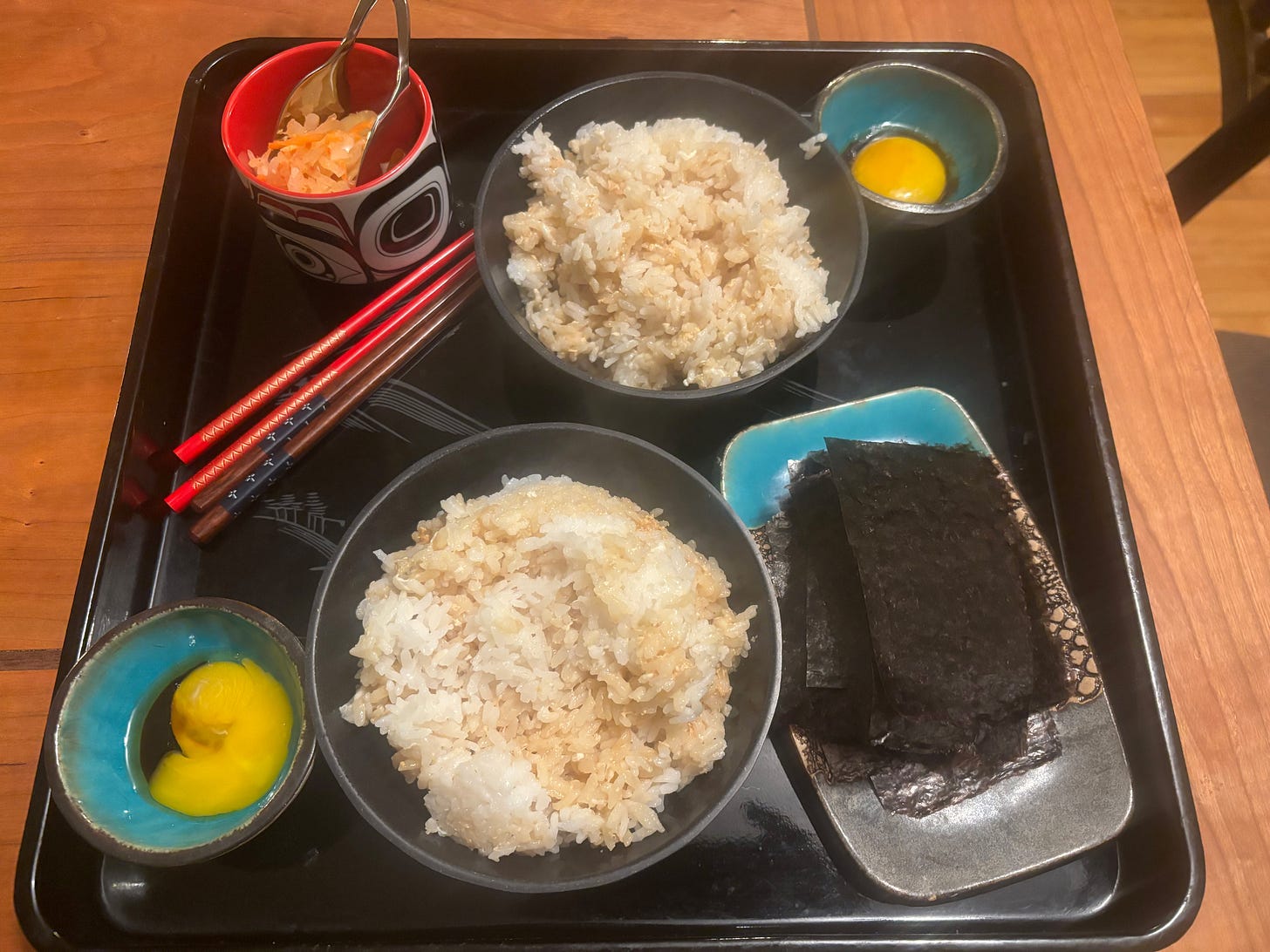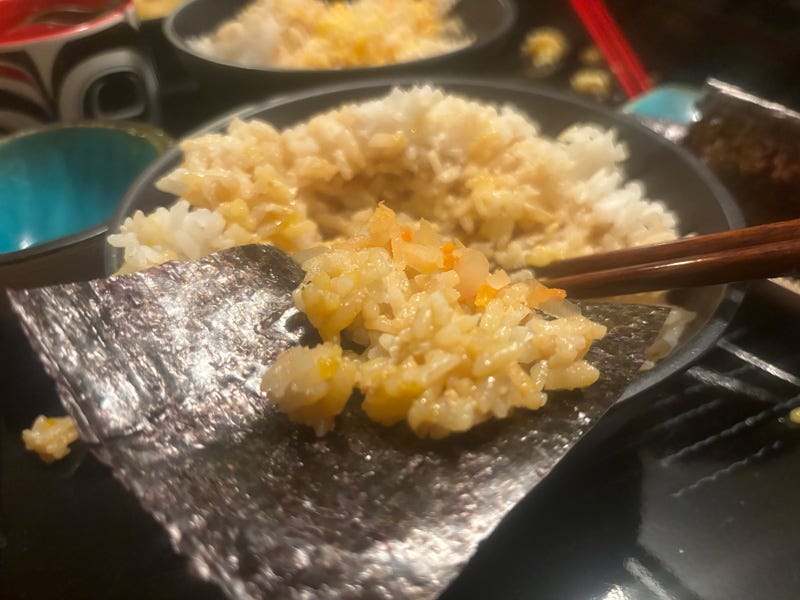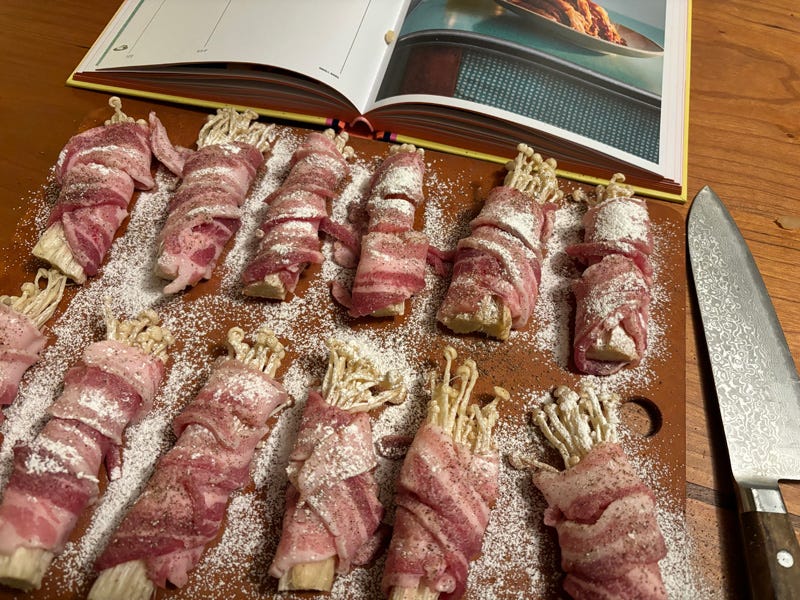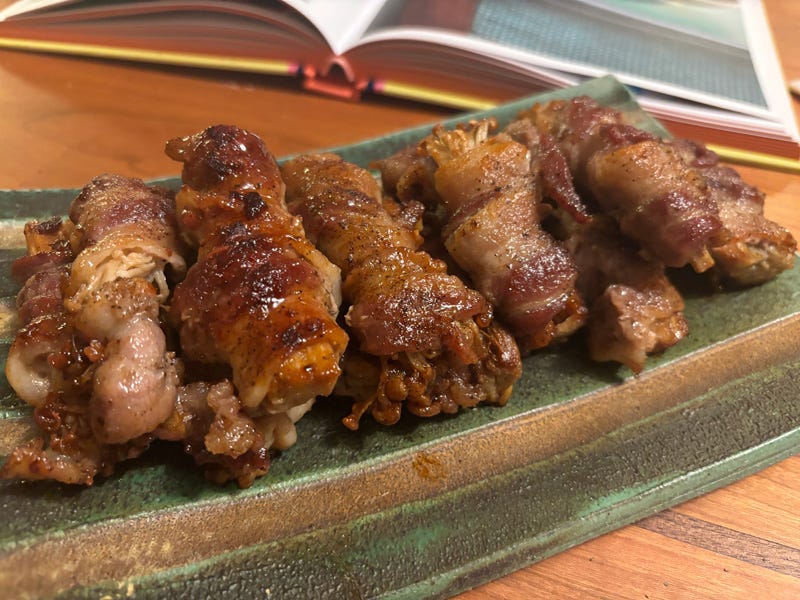THE COOKBOOK TEST #0026: JAPANEASY BOWLS & BENTO: PART TWO
INSTALLMENT #0026 (FREE) A TASTY DOSE OF ANTI-AMERICANISM / THE AUTHOR'S VOICE / THE NOTORIOUS TKG / ENOKI BACON ROLLS
Dear Readers,
If there's a single thing that I think about almost as much as food, it's identity. For many of us, being American is a comfortable second skin - its meaning, largely positive, is self-evident and not worth much questioning or exploration. America rules!
For me, it's more challenging. As a student of history I'm aware that the nature of Americans' identity has been constantly evolving, and has included some pretty unsavory stuff. (Briefly and incompletely: deeply ingrained racism and antisemitism, self-aggrandizing colonialism, and an increasing modern tendency to associate wealth and comfort with spiritual and moral righteousness.)
And as an occasional world traveler (Spain, Israel, Jordan, Poland, New Zealand, etc.) I'm aware that there are aspects of living in other countries - often relating to community, food, walkability, and artistic good taste - that often vary from and even best that which we take for granted here in the States.
That's a long, self-absorbed, probably overly complicated wind-up for the second part of a book review aimed at a cookbook focused on Japanese bento boxes and rice bowls. But it sets the stage for what I want to say: when it comes to day-to-day meals, we Americans cheat ourselves. All the time. It's not that we need to painstakingly make gorgeous homemade feasts whenever we sit down to eat.
But we sell ourselves out constantly: with unsatisfying fast food that we wolf down while driving in our cars [1], with chemically saturated meal-replacement bars and shakes that barely qualify as "food" to begin with, and with meals that wouldn't exist if you deleted all the various sugar and sugar-like and processed carb-like ingredients that make so much of what we eat a mere variant on a Doublestuff Oreo and/or a bag of flavor-blasted Doritos.
Go overseas almost anywhere and you'll see people eating simply, often on the street, in ways that are quick, easy, affordable, and considerably tastier and healthier than an Oscar Mayer Lunchable.
And that's where we get to the Japanese bento box: assembled from bigger cooking or pickling efforts done days or weeks earlier, it's quick to pack, quick to eat, complex, delicious, and a tribute to good, real food as fast, convenient food. There is no reason we need to stab ourselves in the gullet every weekday - we could be making a few special somethings on Sunday evening and reaping the rewards midday throughout the week. That's at least part of the promise of JAPANEASY BOWLS & BENTO, by Tim Anderson. This week, I'll dig into a couple more of its recipes to see how much the book lives up to the fantasy.
at your service,
James
JAPANEASY BOWLS & BENTO
BY TIM ANDERSON
HARDIE GRANT BOOKS | 2022 | $35
Now that I've had more time to bomb around the interior of this book, I'm pleased to report that it holds up - Anderson's voice is cheerful, focused, and consistent throughout. There are stories and useful context for most of the recipes, but nothing that feels self-involved or self-important - it's modest, thoughtful, helpful stuff from stem to stern.
Anderson skillfully walks the line that most cookbook authors tread - he's confident enough that you'll follow him into the kitchen and give his food a try, but he's not so arrogant that you feel intimidated and/or hostile. It's important to give your readers permission to follow in your footsteps, and you want them to feel welcome, but you also want to let everybody know that you're not an influencer who is taking their very first pass at something that isn't a 45 second vertical aspect ratio video.
THE NOTORIOUS TKG
I was drawn to this “hot rice plus raw eggs plus pickles” recipe because it seemed less like a recipe than a method of throwing some stuff together to eat while you're drinking. Some of the tastiest things out there (toad in the hole, lots of spaghetti variants, many kinds of sandwiches) are sort of just culinary cries for help from partially incapacitated people, and this recipe, which is kind of just sticking eggs, rice, and kimchi into little seaweed packets, really seems to be part of that family of food.
After executing this recipe/method - absolutely. This is a lovely, gorgeous, easy-going way to eat after you drink. Get your rice going, and while it's cooking break as many eggs as needed into as many ramekins, cut up some sheets of nori, grab your kimchi, hydrate a little and you're off to the races with an incredibly simple, creamy, mellow, sustaining, late-night rice nosh.
Stone cold sober, it's a little basic, but not bad at all. Were I to do it again (again, sober) I think I'd add some scallions, maybe chopped up roasted vegetables, some sriracha, etc. until I was firmly in homemade rice bowl territory.
TAMAGO KAKE GOHAN
a few drops of sesame oil
2 Tbsp plus a few drops of soy sauce
2 eggs
2 portions of freshly cooked or reheated rice
10g (1/2 oz.) of butter
kimchi or other pickles
2 sheets of Japanese nori, cut into six small rectangles
Grease two small ramekins with sesame oil.
Add a few drops of soy sauce to each ramekin, separate your eggs, and put the yolks in the ramekins. Beat the whites with the remaining 2 Tbsp soy sauce.
When rice is finished cooking and piping hot, fold the egg whites and butter into the rice.
To serve: pile rice into bowls and slip the egg yolks on top. Break the yolks with chopsticks, and then pack some eggy rice with kimchi or pickles onto squares of nori, making tasty little parcels. Eat each roll as soon as you make it so it stays crispy.
ENOKI BACON ROLLS
The Enoki Bacon Rolls from Japaneasy appeal to me for a variety of reasons. There's something about taking a sublime vegetarian ingredient like mushrooms and wrapping them in bacon that feels - both wrong and right. And they remind me of one of my favorite, old-school Japanese recipes, the okonomiyaki (grilled as you like it thing) which is a whole bunch of cabbage and carrots and yams with just a little grace note of pork and Kewpie mayo.
They look relatively simple to execute and substantial without being overwhelming - a perfect meal-snack-appetizer straddling thing. And the words "you can serve these at any temperature" are pretty much music to my ears.
Now, here's the thing: these went completely sideways on me. And I know precisely what happened.
The recipe called for "unsmoked bacon" but the introduction said that nikumaki recipes like these traditionally used pork belly. The Asian grocery store I visited didn't have bacon, but it did have sliced pork belly - seemed like a pretty solid substitute.
I made the bacon rolls, and they looked terrific. I cooked them as directed (6-7 minutes per side), drained the fat, cooked them in the sake sauce, and plated them. Browned, crispy exterior, gorgeous looking.
And yet... nikumaki apparently lives or dies based on THINLY SLICED strips of pork, and the grocery story pork belly I bought was thickly sliced, or at least medium sliced. This meant that while the Enoki Bacon Rolls looked done, and the mushrooms were done, and they were all (apparently) ready to enjoy, the pork belly strips were still leathery, tough, and more or less inedible - crispy on the outside, undercooked in the interior.
Given pork belly or unsmoked bacon that I knew was ready-for-the-grill-it-yourself-steakhouse thin, I might actually attempt these again - the sauce was tasty, the mushrooms were creamy and delicious, and the complementary joy of perfectly cooked wrapped pork would have made these a really entertaining snack. But with conventionally cut pork - no go. A longer sizzle might have eventually cooked them through, but at the expense of the mushrooms, which were delicate and at the end of their rope when I plucked them from the saute pan.
ENOKI NO BÈKON MAKE
200g (7 oz.) enoki mushrooms
12 strips of unsmoked bacon QUITE THINLY SLICED
black pepper to taste
about 1 Tbsp cornstarch
1 Tbsp vegetable oil
1 Tbsp sake
1 Tbsp mirin
1 Tbsp soy sauce
Cut about an inch off the bottom of the enoki cluster and discard. Break the mushrooms into about 12 little bundles, and wrap each with a strip of bacon at an angle so the bacon covers almost all of the mushrooms.
Season well with black pepper on all sides, and then dust all sides with cornstarch, using a sieve or tea ball to sprinkle it evenly.
Heat oil in a large skillet on medium heat, then add the rolls, frying for 6-7 minutes per side, turning and repeating halfway through.
Use a paper towel to sponge away excess fat in pan, then combine sake, mirin, and soy sauce and pour over the rolls. Toss them to coat evenly. When liquid has reduced to thick glaze, remove from heat and serve.
Serve at any temperature; they'll keep for four days in the fridge.
FOOTNOTES
[1] AUTHOR'S NOTE: I had two Taco Bell soft tacos and a beans and rice burrito for dinner tonight. Plus a soft drink.[2] Listen, I'm not proud of that. I note this for the sake of transparency and to say: "I am ABSOLUTELY part of the problem here." I am intent on both throwing rocks and living in a glass house, and I accept that a certain amount of self-destructive property damage is going to be the price that I pay.
[2] AUTHOR'S NOTE: A roughly even distribution of Pepsi, Mountain Dew, and Cherry Pepsi in a paper cup. We always called these mixed up beverages "suicides" in high school, which is an unfortunate name, so if you know a different and better name for this practice I'm open to switching my verbiage.







I always heard "suicide" as a description of the mix of all the slushie flavors. You're right, there's got to be a better name by now?